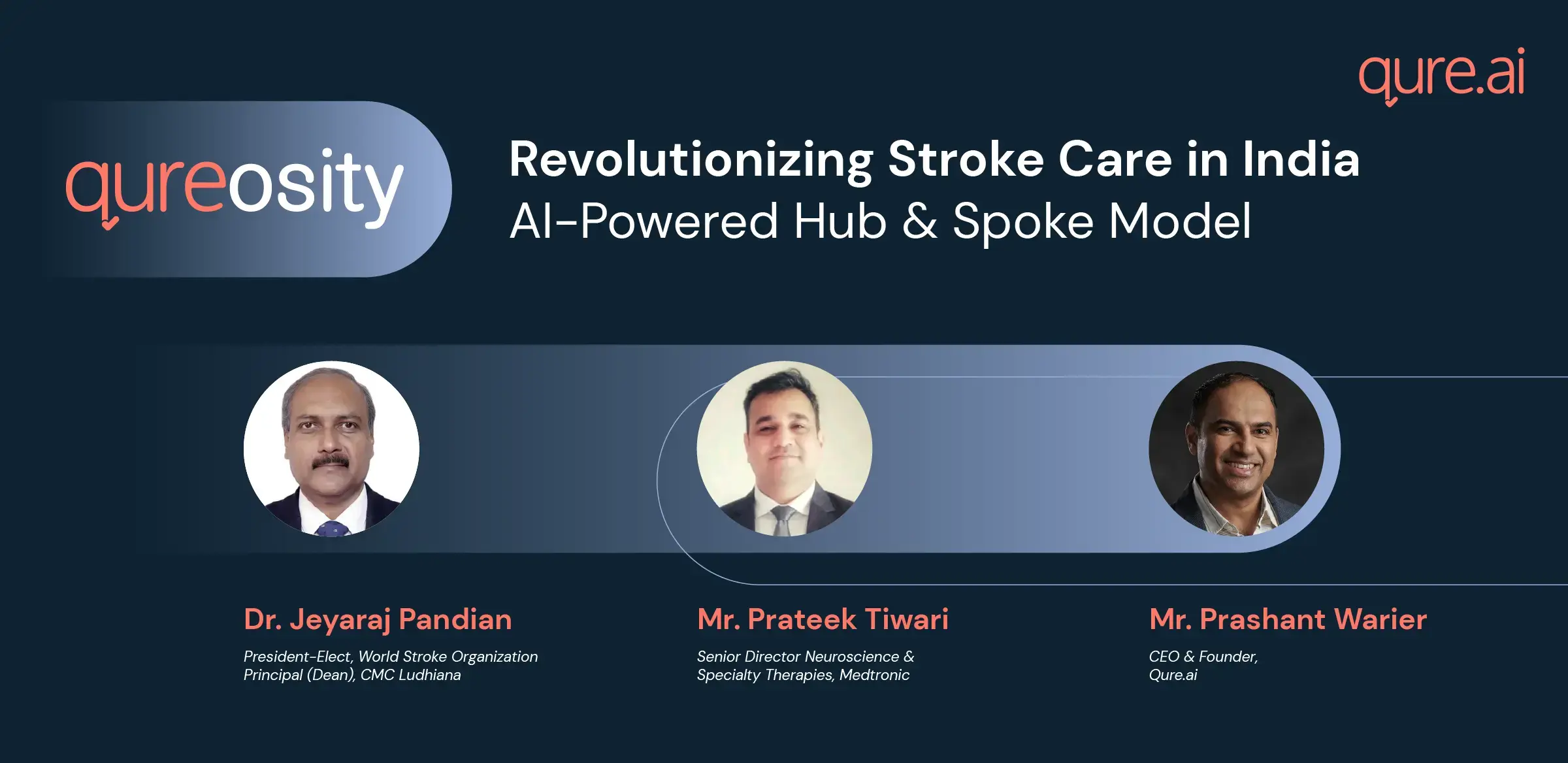We stand at a critical juncture —a burgeoning healthcare crisis and a technological renaissance.

Back
As India faces an epidemic of stroke cases, yet another area of the healthcare system reels under the pressure of necessity. However, the silver lining in this formidable cloud appears in the form of technological innovation, particularly artificial intelligence (AI).
A recent webinar spearheaded by Prashant Warier, CEO and founder of Qure.ai, brought together a cadre of experts, including Dr. Jeyaraj Pandian, President-Elect of the World Stroke Organization, and Prateek Tiwari, Senior Director of Neurosciences and Specialty Therapies at Medtronic.
This assembly of minds explored the challenges and potential solutions in revolutionizing stroke care in India.
Challenges in Stroke Care
A sobering portrait of stroke care in India was illustrated by Dr. Pandian, highlighting the grim statistics of approximately 1.7 million new stroke cases annually.
The morbid variance in fatality rates, which could soar up to 60% in some regions, lays bare the disquieting disparities in healthcare. An "integrated approach," a term more ornamental than operational in the current scenario, is a hope to bridge the split between private and public healthcare systems.
The scarcity of specialized personnel adds another layer of complexity. One neurologist per one million population is an unsettling statistic that speaks volumes about the yawning resource gap in India's healthcare system.
Touching on the economic facets of stroke care, Pandian reveals how funding is available under the state NCD program and urges healthcare professionals to tap into these resources: "A stroke champion from each state could approach the government and mobilize those funds."
The Hub & Spoke Model
The Hub & Spoke model enters this narrative as a potential deus ex machina, aiming to redraw the topography of stroke care.
As elucidated by Prateek Tiwari, this model could act as a time-efficient system by ensuring that time-sensitive treatments are administered promptly. The architecture of this model, where "spokes" or primary healthcare facilities funnel into specialized "hubs," aspires to alleviate the challenges above.
Tiwari also highlights the significance of artificial intelligence in expanding the hub-and-spoke model, asserting plans to establish 20 to 30 centers across India within a year.
AI in Radiology: The Crucible of Possibilities
Tiwari delivers a sobering statistic: 'The number of deaths from stroke is much higher than patients who died because of COVID,' emphasizing the acute need for rapid healthcare infrastructure expansion.
Here, AI emerges as a fulcrum that could tip the balance in favor of efficiency and accuracy.
Machine learning algorithms can parse radiological images to identify candidates for treatments like mechanical thrombectomy with speed.
A highly instrumental role in fast-tracking diagnostic processes allows AI to metamorphose the "golden period" for stroke care—a critical 24-hour window—into a more attainable goal.
But how exactly does AI imbue the Hub and Spoke model with new dynamism? The essence lies in:
- Swiftness in Decision-making: Machine learning offers rapidity and precision, ushering in quicker therapeutic decisions.
- Optimal Resource Utilization: AI's discriminatory capacity in flagging only the most critical cases ensures that expert human resources are judiciously allocated.
- Accessibility at the Grassroots: Spoke facilities equipped with AI can conduct preliminary analyses, distributing healthcare resources more equitably.
- Data-Driven Governance: The accumulated data can serve as a guiding light for policy interventions, procedural improvements, and preventive strategies.
An Ecosystem of Global Health & AI
In a striking development, the World Stroke Organization (WSO) is extending its tendrils into India, fostering a robust platform for international collaboration.
The signing of the New Delhi declaration before the G20 summit marks a watershed moment in global stroke care and offers a template for other countries.
What distinguishes the Metronome-Artemis partnership, as explored by Tiwari and Warier, is the accent on creating a value-laden ecosystem. AI's application transcends the technological realm to align itself with healthcare imperatives.
This entails meticulous skill development, staff training, and a resonance between AI and existing policy frameworks.
Dr. Pandian's discussion on quality-indicator registries like Rescue and the Indian Stroke Hospital Registry uncovers another facet of the discourse. These platforms are more than mere metrics; they signify a feedback loop enabling continuous improvement in stroke care.
"Our partnership with Artemis Gurgaon exemplifies our approach to collaborative healthcare. As a leading neuro intervention center, Artemis is a hub hospital in our network, facilitating timely interventions for stroke patients."
Here, Prateek Tiwari delineates the importance of hub-and-spoke models in healthcare. By forming strategic partnerships with key institutions like Artemis Gurgaon, the initiative aims to enhance stroke care efficacy.
Towards a More Compassionate Healthcare Ecosystem
"In considering AI or any emerging technology, the imperative is clear: create value. Value for the patient, the healthcare provider, and the larger medical ecosystem."
Prashant Warier here brings a crucial perspective to the dialogue, stressing the need for value-based technology adoption.
As he puts it, technological solutions must offer tangible benefits across the healthcare spectrum to be considered successful.
Weaving together global initiatives, technological advancements, and rich empirical evidence, India is sculpting a unique narrative in stroke care.
This is a crucial moment in healthcare --multidisciplinary collaborations have set the stage for a new healthcare epoch that promises to be more accessible, precise, and compassionate.
The webinar, thus, serves not merely as a lens to view the current challenges but as a prism refracting the multitudes of opportunities that lie ahead.
In this evolving landscape, AI and policy interventions may be the twin helixes in the DNA of a revolutionized stroke care ecosystem in India.